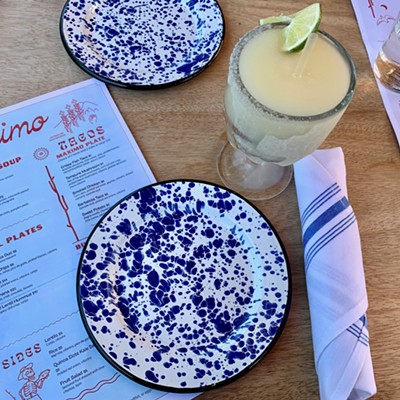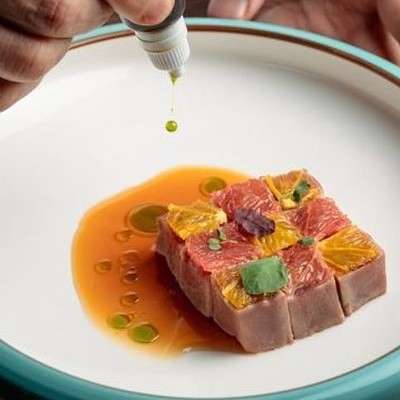Arthur Ave opened in the Heights at the crest of the wave of success found by its sister restaurant, Evan Turner’s wine-obsessive Helen Greek Food and Wine in Rice Village. The concepts are strikingly different, and yet share a core purpose. Where Helen is a Greek restaurant wrapped around Turner’s beverage program, existing primarily as a vehicle to elevate what he sees as some of the world’s great unsung wines, Arthur Ave is cuisine-focused in concept, lending a shiny new veneer to red sauce and checkered tablecloths.
Updating and upselling Italian-American staples has been in vogue for a few years now. It can be difficult to translate a historically modest, inexpensive cuisine into a finer-dining setting. Tweak the food too much, and it struggles to keep its identity. Don’t tweak it enough, and diners struggle to find the difference in the distinction. While Arthur Ave can be a swell place to eat, it falters on both of these counts.
Take the much talked-about Crispy Lasagna. It can be hard to make something as homey, common-seeming and traditional as lasagna seem vibrant and new, and Arthur Ave’s attempt is an admirable one, at least in its goals. Arthur Ave’s isn’t the first kitchen crew to focus on the much-loved crispy-edged corner pieces of the lasagna. No less a culinary luminary than Massimo Bottura — owner of world-renowned Osteria Francescana — has tackled the same concept. But Bottura was setting out to fundamentally change the nature of the Italian kitchen. The menu at Arthur Ave makes no such suggestion, leaving the dish a bit of a puzzle. While it’s an interesting concept, it may well leave diners unsatisfied.
In the end, the crispy lasagna leaves you wondering how to eat it, my daughter asking, pointedly, “Is it like nachos?” The outer edges have an oily sheen and a hollow puff too reminiscent of random Chinese take-out fried wontons, the nacho-style layering leaving a drastically uneven distribution of both components and seasoning.
To enjoy it at its best, you more or less have to eat it in slightly ungainly wedges, edge to center, making sure you get a dusky, briny olive with each “slice”; it seasons the whole bite. Eating it this way makes it make sense, in trying to emulate those lusted-after corner pieces while preserving the soul of the lasagna you are looking for, but I think it’s a better idea than a dish, and an idea perhaps better suited to a different restaurant than one whose basic MO purports to elevate the central ideas of Italian-American cooking. Lasagna, in that vernacular, is a comfort dish. If anything, this riff is slightly discomforting, offering many wasted, obnoxious bites for a pittance of great ones. It could be that a bit of simple tinkering might preserve the intent of the changes, while better honoring the reliable classic in its own right. Namely, layer it more classically, béchamel and Bolognese spread further from the center, giving it more connection to its cousin while still managing to differentiate with its crunchy outer edges.
Arthur Ave’s Caprese — another riff on an often stodgy standby — sings because of its format changes. For starters, the pulled-to-order mozzarella is a thing of beauty. The cheese is still body-heat warm as it arrives, a slightly flattened disk, showing the marks of its recent pulling. It is tender and creamy, full of life, almost breathing. The dish plays out in the expected colors, but in a strikingly different format than the spread deck of cards most versions emulate. Round little tomato jewels, multi-toned and glistening, dot the plate around that tender, milky-sweet cheese, itself perched on curlicues of arugula with verdant olive oil and a sheen of ruddy balsamic pooled underneath. Peeled tomatoes (a lovely, delicate touch) burst sweet-tart, glazed with basil essence. Grassy olive oil and those pop rock fruits provide all the dressing that the tender, lightly spicy and bitter arugula needs, all of it playing against the sweet, milky cheese. It tastes enough like what you’re expecting to make all the right connections, but different enough to form new ones. It is playful, exciting and utterly delicious, and it just might ruin you for all other capreses. My only gripe is that the balsamic often comes on a bit too strong, threatening to tilt the delicate balance of flavors into overly sweet-tart territory. It’s a value-adder whose value is primarily one of perception. Those lovely little tomatoes do the job well enough with the acidic assist.

With the eggplant parm, the eggplant itself is sliced super-thin, and takes on a dense meatiness.
Photo by Chuck Cook
The eggplant itself is sliced super-thin, and takes on a dense meatiness. It’s lightly breaded and crisped just enough to stand up to sauce and cheese, without taking on an ounce of extra weight or an overly fried flavor. You can taste the eggplant. You can taste the herbs in its coating. You can taste the bright, simple sauce underneath. The thin mantle of cheese clings to each slice, offering just the right touch of richness but allowing the dish to remain light and lithe. It refuses to get soggy. It is more than the sum of its parts and it may well be the best eggplant parm I’ve ever had. It’s also deceptively filling, without coming across as remotely gluttonous. It is the epitome of balance.
Red sauce shows up on pastas and pizzas as well. It shows up in a fine rendition of spaghetti and meatballs, the pasta snaking down the plate in a serpentine coil, meatballs perched on top. There’s a slight funk to their richness, and they have a nice tenderness; fluffy with just a bit of chew. The spaghetti borders on being overcooked, a theme we ran into a few times.
The same issue afflicted an order of Sunday gravy, though it may be more forgivable here. The menu describes the dish as “slow-braised meats in red sauce, served with spaghetti,” and the meats are indeed the star. On a half order (large enough to feed two with a starter or salad to split), a pile of everything from pork belly to sausage comes heaped alongside a reasonably large portion of pasta. The meat flavors the sauce, which takes on a deep and varied richness, becoming blissfully tender in the process. Some of the larger pieces of beef (short rib, perhaps?) seem to have given up their flavor overmuch, and the plate wants for a bit of salt. Despite those few gripes, it sparkles with the generosity of imagined nonnas, fussing all day over the stove while the family gathers.
The other entrées fare less well. A braise of lentils and sausage came out with overly firm lentils, bathed in what tasted like not much more than butter and far too much salt, and showered in far too many fried things. The crispy potato never seemed to materialize, and the fried sage dominated what the salt hadn’t already obliterated.
Pan-roasted trout boasts a delicately crispy surface, and delicately flaky flesh, the two separated by an incongruously tough and clingy membrane. Marinated olives — they show up across the menu, from the antipasti to the lasagna — overpower the delicate fish with their oily, resinous insistence. I think they belong here, just not in such force and form. Slice them thin and distribute them sparingly, rather than haphazardly tossing them about the plate, shout-y orbs that force themselves to the fore with every bite. They refuse to let the delicate sweetness of shaved cauliflower and raw leaves of Brussels sprouts get a word in edgewise, and I’d like to hear what they have to say.

Arthur Ave offers a fine rendition of spaghetti and meatballs, the pasta snaking down the plate in a serpentine coil, meatballs perched on top.
Photo by Chuck Cook
Ultimately, Arthur Ave has its appeal. Many of its standards do their jobs well, and there is a spark of creativity in the kitchen that occasionally raises a traditional dish to new heights. Sometimes, those heights provide a greater distance to fall. Such is the risk of meddling with beloved dishes. While figuring out what a dish can be has its merits, it’s often dangerous to miss the merits of what a dish already is. If Arthur Ave can figure out a way to do that with the rest of the menu as deftly as it does with its jewel of a caprese, or with its standard-setting eggplant parm, the diners at those noisy tables could well become family.
Arthur Ave
1111 Studewood, 832-582-7146, arthuravehou.com. Hours: 3 p.m. to 10 p.m. Monday through Thursday, 3 p.m. to 11 p.m. Friday, 11 a.m. to 11 p.m. Saturday, 11 a.m. to 9 p.m. Sunday
Caprese $16
Lasagna $21
Ace High $10
Spaghetti and meatballs $16
Eggplant parm $19
Sunday gravy (half order) $19
Pan-roasted fish $28
Grilled Italian sausage $16








